
Dory Wins Silver Goblet in Red Baron Fight XXXIII
By winning her 2nd Red Baron Fight in Lewisville, Indiana on April 16, 2022, Dory moved into a five-way tie for fifth on the all-time win list with Ethan Skinner, Scott Jones, Michael Morgan and Graham Shepfer in the Indy Squadron spring classic that replicates the battle in which Germany's leading ace lost his life on April 21, 1918.
This year's result came via an overwhelming and unlikely win for the Germans. Red Baron Fight had been a five-player battle on seven previous occasions with the outnumbered Camels winning 4 Silver Goblets outright and never finishing below second place until this year, when the British suffered a historic defeat. The 33rd Red Baron Fight matchup was as follows:
Germans:
Stephen Skinner Albatros DVa 180 hp
Ethan Skinner Albatros DVa 180 hp
Dory Oda Fokker DrI (all red)
British:
Rick Lacy Sopwith Camel 130 hp
Stephen Dale Skinner Sopwith Camel 130 hp
Rather than leave, Stephen Dale continued to support his sole wingman (Rick) as best he could with his 70 mph turn speed and on Turn 8, all five planes finally came together in a brief but torrid engagement. Rick's Camel fired on Stephen's Albatros and smoke began pouring from the German's Mercedes engine. The Albatros suffered no performance penalties, but with 3 hits in the engine and the shooting penalties caused by the smoke, Stephen believed that his chance to win the Silver Goblet was long gone.
At the same moment, Stephen's Albatros fired head-on at Stephen Dale but missed while both Dory's Triplane and Ethan's Albatros double-attacked Rick's Camel with epic results. Dory and Ethan inflicted three critical hits on Rick's Camel in a single turn of firing. Shot to pieces, the Camel could fly only at 60 mph and could make no right turns, making this one of the pivotal turns of the game. Both Camels were now severely damaged and hanging on for dear life, but the action was far from over.
On the 9th turn, Rick cut the engine of his battered Camel and began gliding toward Australian lines. With poor initiative numbers and believing he had no hope of winning, Stephen chose to dive his Albatros onto Rick's tail and escort him to the ground. This would hopefully prevent Rick from re-starting his Camel's engine and flying away, thereby confirming the kill for either Ethan or Dory (both of whom had contributed to Rick's demise). If he couldn't win, Stephen felt his best efforts might still secure an RBF victory for one of his wingmen.
But Stephen Dale, despite his desperate situation, managed one final shot at Ethan's Albatros and cut the German's aileron cables (the same devastating 4/4 wing critical that had taken Rick's Camel out of contention). With his Albatros unable to turn either direction without falling out of control, Ethan had no choice but to make his escape and eventually land safely at his home field. Stephen Dale had wisely tailed Ethan to put him under cards immediately prior to his escape. With Stephen's smoking Albatros busily escorting Rick's gliding Camel to the ground and with Ethan's Albatros now heading home, Stephen Dale was able to engage Dory's Triplane in a one-on-one battle, if only for a few moments.
Flying the only undamaged airplane in the fight, Dory (red DrI) quickly gained the upper hand over Stephen Dale's Camel and scored on several good shots. Meanwhile, Rick's gliding Camel had turned too tightly, fallen out of control and crashed, which allowed Stephen's smoking Albatros to rejoin the fight.
Just as Stephen's Dale's lone remaining Camel over-dived and finally out-rolled Dory's Triplane to break free from her repeated attacks, Stephen's Albatros dove in for a final shot and scored 3 hit points on the Camel from the top. After that, Stephen Dale cut his engine and glided to an emergency landing in Allied lines to end the fight.
It was decided that the tournament points for Stephen Dale's Camel victory were to be split between Stephen and Dory. The victory credit for Rick's Camel was awarded to Ethan by card cut, while the credit for Stephen Dale's Camel went to Dory.
Of the seven 5-player games in Red Baron Fight history, the 2022 event is the only instance in which the Camel team was thoroughly beaten. In every other 5-player Red Baron Fight a Camel has finished in either first or second place. But critical hits were the deciding factor in Red Baron Fight XXXIII and for the first time in RBF history, the British came up short.
Final scores:
Dory Oda, Fokker DrI (all red) 87 points
Stephen Skinner, Albatros DVa 180 hp 61
Ethan Skinner, Albatros DVa 180 hp 45
Stephen Dale Skinner, Camel 130 hp 41
Rick Lacy, Camel 130 hp 36
April 16, 2022 gaming was held at a local residence in Lewisville, Indiana. The last of three games played that day was designed by Ethan and dubbed the "Ammunition Barge" mission. It was a fun and creative setup that had a British Felixstowe bomber (Ethan) escorted by an outdated Nieuport 27 fighter (Rick) on a special mission to destroy an enormous barge coming in to dock at a North Sea harbor, laden with tons of artillery munitions. The dock was heavily defended by anti-aircraft fire, while the ammunition barge was protected by a pair of escort ships with anti-aircraft capabilities. A German Junkers DI (Stephen, LTN Jurgen Ulf, 18/6) and a Pfalz DXII (Stephen Dale) flew in opposition. The situation for both sides was compounded by the bad weather which formed a heavy cloud bank from 1800-2200 feet and the fact that the ammunition barge was making its final approach just a few hundreds yards from the dock. The result was a fun mission that utilized a number of rarely seen factors in Dawn Patrol in addition to the time element as the barge sailed into the bay to unload its cargo.
The game was cut short by when Stephen Dale needed to leave, in addition to Ethan's bomber sinking the ammunition barge on its first attempt. But the game was tremendous fun and we are saving it to be gamed again later with more players.
The day's second game was Red Baron Fight XXXIII, detailed above.
The first game of the day was set in September 1918 and featured a pair of rarely seen Ansaldo AI Italian fighters flown by Rick and Ethan, which are quite a sight to behold when they hit 140 mph. Stephen and Stephen Dale defended an Austro-Hungarian balloon in a pair of Oeffag Albatros DIII 253's. The Italians flamed the balloon with 14 hits on their first pass, after which the Albatri double attacked Ethan's Ansaldo and shot it down with the credit going to Stephen Dale.
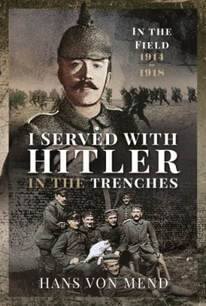
Book Review: "I Served With Hitler in the Trenches" by Hans von Mend
Published by Casemate Books
Hardcover
118 pages
This amazing book is essential to anyone who wants to understand the 20th century or either world war. Originally penned long before post-World War II literature recreated Adolf Hitler in the role deemed necessary for the victors, this work is a trench-level view of the Fuhrer as seen by those who fought alongside him at Passchendaele and the Somme.
"I Served With Hitler" is not untainted by the political demands of its time, yet it remains one of the few accounts of the German leader's personal experiences in World War I. The author, who was in the trenches with Hitler in 16th Bavarian Reserve Infantry, openly admires Hitler's bravery under fire as a lance-corporal runner who delivered messages daily while dodging British sniper bullets.
At just 118 pages, the book is readable, enjoyable, and features an array of photos including rare depictions of Hitler as a 25-year-old infantry recruit as well as examples of the superb art for which he was known. I am not an admirer of any politician, but anyone can clearly see that Hitler was genuinely talented with brush and canvas. One is left to wonder what the world would be if he had stayed true to his calling and remained an artist.
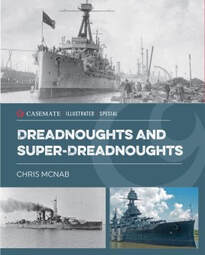
Published by Casemate Books
224 pages
Hardcover
Dreadnoughts are generally considered the "super battleships" that dominated the high seas for some 35 years after being introduced by the British in 1906, usually carrying enormously powerful guns, being nearly two modern football fields in length, with a complement of a thousand or more personnel. In this article, we will review "Dreadnoughts" through the eyes of World War I board gamers.
This book is tremendously useful to board gamers because it features over 200 illustrations of various types including photographs (some colorized), paintings and most importantly, overhead profile diagrams of many different dreadnoughts from several different nations. These diagrams can easily be adapted for board gaming use by copying them, re-sizing them to fit your game board, and crafting them into individual counters for game play. This task alone makes the book a worthy addition to any wargamer's library, despite the relative lack of information on what anti-aircraft capabilities these huge ships boasted.
But "Dreadnoughts" is much more than a collection of diagrams. Author Chris McNab puts forth a splendid effort to let the reader understand just what life was like aboard a warship in choppy seas sailing to its fate at the Battle of Jutland. Some of the photography is simply superb. The description of ranks, personnel, their respective duties and the role of the dreadnought in World War I is engaging and thorough. This work is highly recommended.
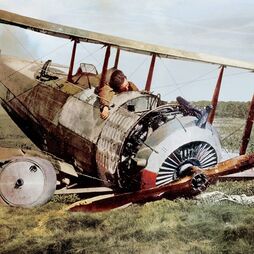
The Indy Squadron rule on victory credits reads as follows:
- Victory Credit/Cuts for Kills
Any player who scored one or more hits on a target on the turn that the target became a kill may cut for the victory credit.
To prevent any future confusion and to clarify the rule's original intent, an additional sentence was added, approved by a 4-0 vote on April 16, 2022 (with one abstention). The full rule will now be amended to read:
- Victory Credit/Cuts for Kills
Any player who scored one or more hits on a target on the turn that the target became a kill may participate in a card cut to determine which pilot gets credit on his mission/kill record. If the target plane was not hit on the turn in which it became a kill, victory credit goes to the last player(s) to have scored a hit factor in the target plane.
This leaves and ever-so-slight possibility that the rule could be used for "vulturing" (stealing credit for kills already achieved or nearly achieved by another pilot). However, it does clarify the intent of victory credit considerably and the window for "vulturing" seems to be slight.
The rules for points credit in tournaments also needs to be revisited at our next gaming day to reflect the clarification above on victory credits. The following language is proposed as an addition to our current Tournament Scoring System (proposed new language in bold):
- +30 for shooting down an enemy aircraft. Kill points are split equally among any pilot who hits the same area that caused the plane's demise on the turn that it becomes a kill, regardless of the number of hits. If a pilot hit is the cause of the plane's destruction, then in order for another player to split the awarded points, he/she must have also a) scored a pilot hit (regardless of wound type), or b) reduced some area of the plane to zero, or c) inflicted a critical hit that would also have resulted in an indisputable kill. In all other cases, points are awarded to the last player(s) to have scored a hit on the target plane.

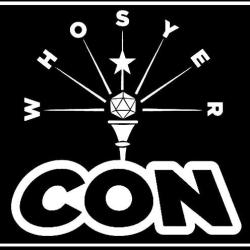
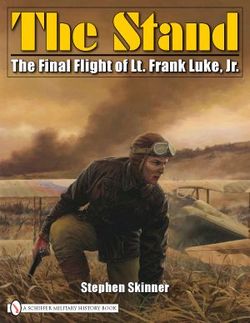

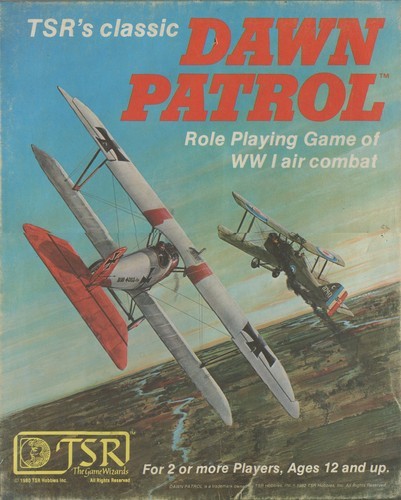
 RSS Feed
RSS Feed


